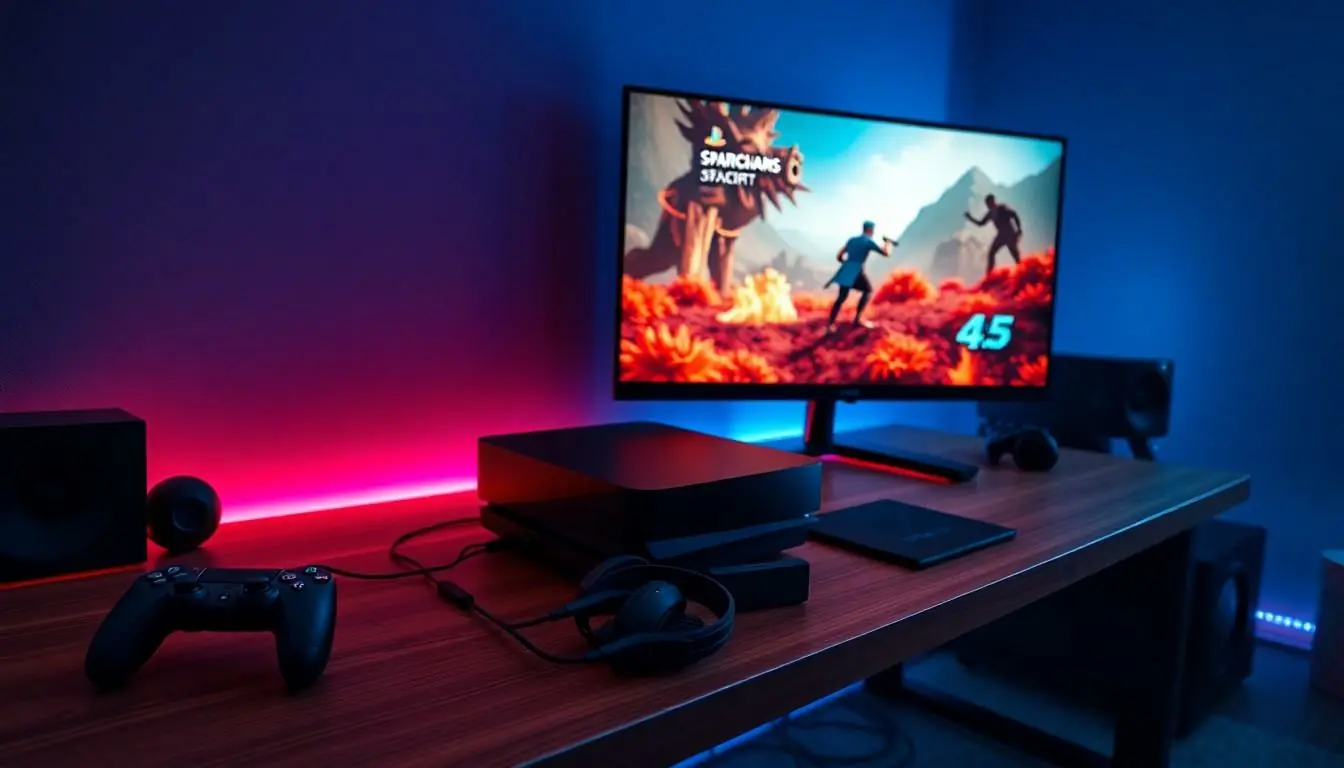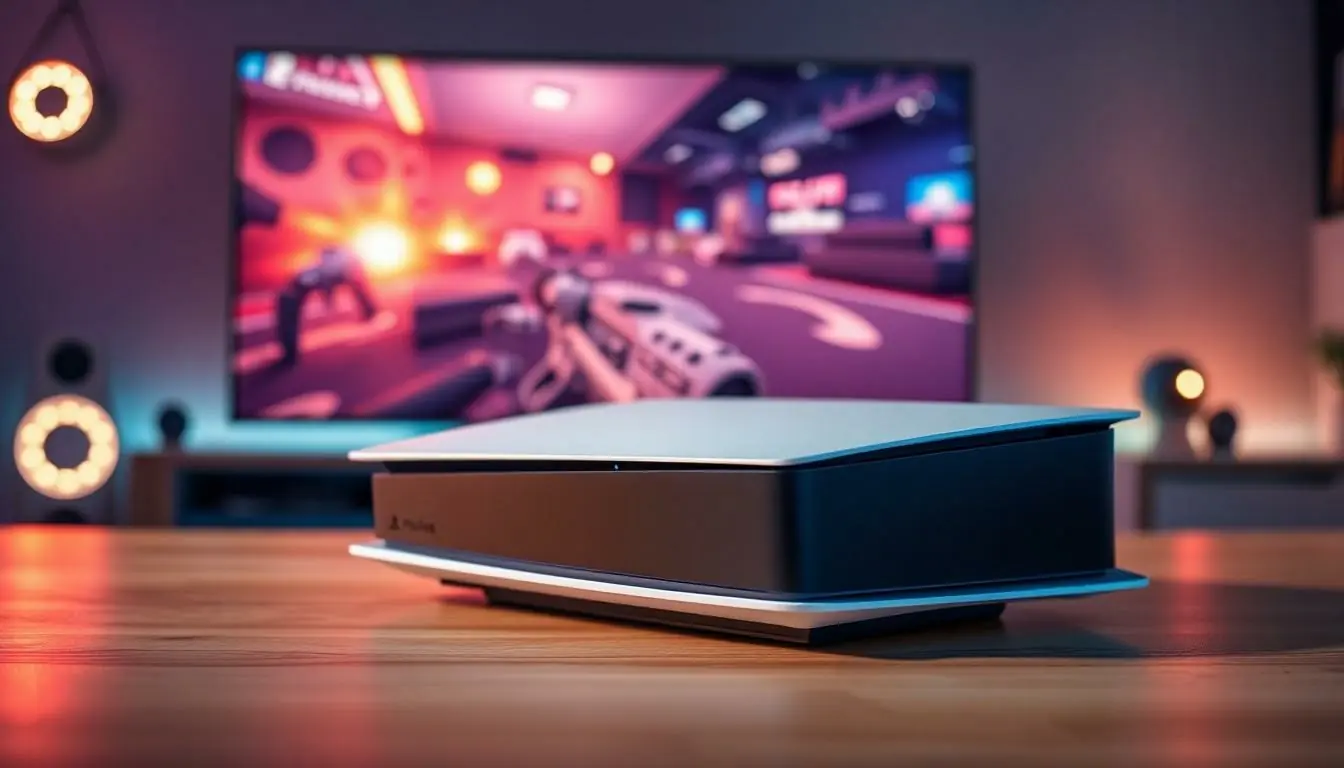Table of Contents
ToggleIn the world of gaming, frame rates can make or break the experience. Enter the PS5, Sony’s powerhouse that promises to elevate gameplay to a whole new level. But just how many frames per second can this beast churn out? Spoiler alert: it’s a lot more than your old console could manage while struggling to load a simple menu!
Overview Of PS5 Performance
The PS5 functions at impressive frame rates, enhancing the overall gaming experience. Gamers enjoy titles running at 60 frames per second (fps) under standard settings. Additionally, certain games support performance modes, allowing players to experience up to 120 fps.
Notably, the PS5 can achieve higher resolutions without sacrificing performance. For instance, several titles maintain 4K resolution while still delivering high frame rates. Advanced hardware components, including a custom SSD and RDNA 2 GPU, contribute to this capability.
Developers leverage the console’s specifications to create smoother graphics and more responsive controls. For example, games like “Ratchet & Clank: Rift Apart” showcase seamless transitions and fluidity at 60 fps. The console optimizes load times, making gameplay interruptions minimal.
Various resolutions and refresh rates cater to different gaming preferences. Players can choose between prioritizing visual fidelity or frame rate, depending on the game title. Most AAA games incorporate settings that adapt to individual preferences for an optimized experience.
Importantly, the PS5 supports features like Variable Refresh Rate (VRR). This technology enhances compatibility with high refresh rate displays, further stabilizing the frame output. As a result, gamers experience fewer frame drops and smoother visuals during intense action scenes.
PS5’s performance capabilities set new benchmarks for console gaming, pushing the limits of frame rates and graphical quality.
Key Specifications
The PS5 features advanced specifications that contribute to its performance in gaming.
CPU and GPU Capabilities
The PS5 utilizes a custom AMD Ryzen Zen 2 CPU, clocking at 3.5 GHz. This processor enhances gaming with its multi-threading capabilities, ensuring efficient performance. Pairing with the CPU is the RDNA 2 GPU, which can deliver up to 10.28 teraflops. This powerful unit facilitates stunning graphics and supports Ray Tracing for realistic lighting and shadow effects. Frame rates significantly improve, reaching up to 120 fps in select titles. Developers leverage these advanced CPU and GPU specifications to optimize performance, creating immersive gameplay experiences.
RAM and Storage Specifications
The PS5 has 16 GB of GDDR6 RAM, providing ample memory for gameplay and multitasking. Speed at 448 GB/s ensures quick data retrieval, allowing for seamless transitions between scenes. Storage options include an 825 GB custom SSD, designed to minimize load times and enhance in-game performance. This SSD achieves read speeds of up to 5.5 GB/s, ensuring minimal interruptions during gameplay. Users can expand storage with M.2 SSDs, allowing for more game installations. Enhanced RAM and storage capabilities significantly contribute to the PS5’s overall gaming performance.
Understanding FPS in Gaming
Frame rates, measured in frames per second (fps), play a critical role in gaming. Higher fps leads to smoother visuals, creating a more immersive experience. The PS5 demonstrates this advantage well, consistently providing 60 fps in many titles under standard settings. Some games even allow performance modes that push this number to 120 fps, showcasing the console’s powerful capabilities.
Performance combines with advanced hardware to deliver stunning graphics. Thanks to its custom SSD and RDNA 2 GPU, the PS5 maintains 4K resolution alongside high frame rates seamlessly. A standout example of this is in “Ratchet & Clank: Rift Apart,” where players experience fluid animations and responsive controls.
Developers leverage the PS5’s specs, ensuring smoother graphics across a range of titles. Reduced load times also contribute significantly to gameplay enjoyment. The console minimizes interruptions, allowing players to dive straight into the action. Additionally, it offers various options to suit individual gaming preferences, including choices between resolution and frame rate.
Variable Refresh Rate (VRR) technology enhances the experience further by minimizing frame drops. This feature is particularly beneficial during intense action sequences, providing a smoother visual experience. With a custom AMD Ryzen Zen 2 CPU operating at 3.5 GHz and a capable RDNA 2 GPU delivering up to 10.28 teraflops, the PS5 pushes performance boundaries.
Equipped with 16 GB of GDDR6 RAM, it ensures quick data access, enhancing overall gameplay fluidity. Players also benefit from an 825 GB custom SSD, which boasts read speeds of up to 5.5 GB/s. Expandable storage options, including M.2 SSDs, allow for even more game installations. Collectively, these specifications position the PS5 at the forefront of console gaming, advancing frame rates and graphical quality.
Common FPS Rates for PS5 Games
The PS5 delivers a range of frame rates across various titles. Understanding these rates helps gamers choose their preferred gaming experiences.
30 FPS Titles
Many titles, particularly those emphasizing cinematic experiences or narrative depth, run at 30 FPS. Games like “The Last of Us Part II” and “Ghost of Tsushima” showcase stunning visuals that complement their storytelling. Although 30 FPS might seem lower, developers optimize graphics and details to enhance immersion. This frame rate often provides a stable experience while maintaining high visual fidelity. Players may enjoy smoother gameplay and visually rich environments through well-designed animations and effects.
60 FPS Titles
Most PS5 games aim for a smooth 60 FPS. Titles such as “Spider-Man: Miles Morales” and “Demon’s Souls” illustrate the performance gains with this frame rate. With 60 FPS, gamers experience more responsive controls, which is crucial for fast-paced action. Additionally, frame rates at this level enhance overall gameplay fluidity. The combination of smooth animations and responsive gameplay leads to an engaging experience, making it easier for players to immerse themselves in game worlds.
120 FPS Titles
Some demanding titles and performance modes hit an impressive 120 FPS. Games like “Call of Duty: Warzone” and “Ratchet & Clank: Rift Apart” utilize high refresh rates to create incredibly responsive and fluid gameplay. With 120 FPS, rapid movements and intense action sequences maintain clarity and precision. Gamers benefit from reduced input lag, making competitive gameplay much smoother. Furthermore, this frame rate allows for greater visual detail during motion, enhancing the overall gaming experience.
Factors Affecting FPS on PS5
Frame rates on the PS5 are influenced by several critical factors, ensuring an optimal gaming experience.
Game Development Optimization
Game developers utilize PS5’s specifications to enhance performance. They implement optimization techniques that target game engines and graphical fidelity. Custom algorithms contribute to improved frame rates during gameplay. Developers also prioritize certain aspects, such as texture quality and lighting, impacting frame rates directly. Titles optimized for PS5 often run at higher fps, showcasing smoother animations and reduced input lag. In addition, patches and updates frequently adjust performance, providing an enriched experience.
Resolution Settings
Resolution settings play a significant role in determining frame rates. Players can choose between various modes, such as performance and resolution. Performance mode typically lowers graphical fidelity to achieve higher fps, while resolution mode emphasizes visual quality. Many PS5 games run at 4K resolution with frame rates capped at 30 fps for a cinematic experience, such as “The Last of Us Part II.” In contrast, titles like “Spider-Man: Miles Morales” utilize performance mode to maintain 60 fps while operating at lower resolutions. Ultimately, players decide their preferences based on gameplay experiences.
Hardware Limitations
Hardware limitations directly affect frame rates on the PS5. While the custom SSD and powerful GPU significantly boost performance, thermal throttling may occur during extended gaming sessions. Users may experience frame drops due to high graphics settings exceeding hardware capacities. Additionally, running multiple applications in the background can compete for resources, affecting overall performance. PS5’s 16 GB GDDR6 RAM allows for quick data retrieval, but demanding titles may still face limitations when pushed to their limits. Therefore, managing hardware load can enhance frame rate consistency in gaming sessions.
Conclusion
The PS5 stands as a remarkable advancement in gaming technology, redefining what players can expect in terms of frame rates and overall performance. With its ability to consistently deliver 60 fps and reach up to 120 fps in performance modes, it offers a fluid and immersive gaming experience. The combination of high frame rates and stunning graphics allows players to engage deeply with their favorite titles.
As developers continue to optimize games for this powerful console, the potential for even more impressive performance is on the horizon. The PS5 not only enhances gameplay but also sets new standards for future gaming consoles, ensuring that players enjoy both speed and visual fidelity in every session.






